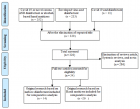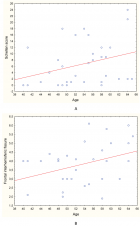Abstract
Review Article
Role of polyamine metabolism in plant pathogen interactions
Magda Pal* and Tibor Janda
Published: 07 December, 2017 | Volume 1 - Issue 2 | Pages: 095-100
Polyamines are aliphatic amines found in all living cells, and they are necessary for several fundamental cell processes. Their protective role against various abiotic stress factors has been reported in different plant species, while the mechanism by which polyamines act during plant-microbe interaction is still poorly understood. The several types of the interactions between the plants and the microbes outline a divers and complex picture of the action mechanisms. The present review focuses on this aspect of the mode of action of polyamines and polyamine metabolism during biotroph and necrotroph interactions between plants and pathogens. It seems that apoplastic metabolism of polyamines of the host and the accumulation of H2O2 as a result of polyamine catabolism play important signalling role in plant-pathogen interactions. The manipulation of the members of the polyamine-induced signalling pathways could increase the host plant resistance to biotic stresses.
Read Full Article HTML DOI: 10.29328/journal.jpsp.1001012 Cite this Article Read Full Article PDF
References
- Tiburcio AF, Altabella T, Bitrián M, Alcázar R. The roles of polyamines during the lifespan of plants: from development to stress. Planta. 2014; 240: 1-18. Ref.: https://goo.gl/zUs4tU
- Valdés-Santiago L, Guzmán-De-Peña D, Ruiz- Herrera J. Life without putrescine: disruption of the gene-encoding polyamine oxidase in Ustilago maydis odc mutants”. FEMS Yeast Research. 2010; 10: 928-940. Ref.: https://goo.gl/7LEY83
- Vuohelainen S, Pirinen E, Cerrada-Gimenez M, Keinänen TA, Uimari A, et al. Spermidine is indispensable in differentiation of 3T3-L1 fibroblasts to adipocytes. J Cell Mol Med. 2010; 14: 1683-1692. Ref.: https://goo.gl/Q14RNN
- Valdés-Santiago L, Cervantes-Chávez JA, León-Ramírez CG, Ruiz-Herrera J. Polyamine metabolism in fungi with emphasis on phytopathogenic species. J Amino Acids. 2012; 2012: 837932. Ref.: https://goo.gl/YP53u5
- Hamdani S, Yaakoubi H, Carpentier RJ. Polyamines interaction with thylakoid proteins during stress. Photochem Photobiol B. 2011; 104: 314-319. Ref.: https://goo.gl/F1RrFS
- Lightfoot HL, Hall J. Endogenous polyamine function- the RNA perspective. Nucl Acids Res. 2014; 42: 11275-11290. Ref.: https://goo.gl/MSAuGr
- Jang EK, Min KH, Kim SH, Nam SH, Zhang S, et al. Mitogen-activated protein kinase cascade in the signaling for polyamine biosynthesis in tobacco. Plant Cell Physiol. 2009; 50: 658-664. Ref.: https://goo.gl/YycgVH
- Hussain SS, Ali M, Ahmad M, Siddique KH. Polyamines: natural and engineered abiotic and biotic stress tolerance in plants. Biotechnol Adv. 2011; 29: 300-311. Ref.: https://goo.gl/Het7fu
- Coghlan SE, Walters DR. Polyamine metabolism in ‘green-islands’ on powdery mildew-infected barley leaves: possible interactions with senescence. New Phytol. 1990; 116: 417-424. Ref.: https://goo.gl/G78REr
- Asthir B, Spoor W, Duffus C. Involvement of polyamines, diamine oxidase and polyamine oxidase in resistance of barley to Blumeria graminis f. sp. hordei. Euphytica. 2004; 136: 307-312. Ref.: https://goo.gl/zUrqdL
- Montilla-Bascón G, Rubiales D, Prats E. Changes in polyamine profile in host and non-host oat–powdery mildew interactions. Phytochem Lett. 2014; 8: 207-212. Ref.: https://goo.gl/1v1Vkp
- Cowley T, Walters DR. Polyamine metabolism in barley reacting hypersensitively to the powdery mildew fungus Blumeria graminis f. sp. hordei. Plant Cell Environ. 2002; 25: 461-468. Ref.: https://goo.gl/LNfrS4
- Gardiner DM, Kazan K, Praud S, Torney FJ, Rusu A, et al. Early activation of wheat polyamine biosynthesis during Fusarium head blight implicates putrescine as an inducer of trichothecene mycotoxin production. BMC Plant Biol. 2010; 10: 289. Ref.: https://goo.gl/3zLsco
- Montilla-Bascón G, Rubiales D, Altabella T, Prats E. Free polyamine and polyamine regulation during pre-penetration and penetration resistance events in oat against crown rust (Puccinia coronata f. sp. avenae). Plant Pathol. 2016; 65: 392-401. Ref.: https://goo.gl/ZqunNv
- Legaz ME, Armas RD, Piñon D, Vicente C. Relationships between phenolics-conjugated polyamines and sensitivity of sugarcane to smut (Ustilago scitaminea). J Exp Bot. 1998; 49: 1723-1728. Ref.: https://goo.gl/bWEvSo
- Wojtasik W, Kulma A, Namysł K, Preisnerand M, Szopa J. Polyamine metabolism in flaxin response to treatment with pathogenic and non–pathogenic Fusarium strains Frontiers Plant Sci. 2015; 6: 291. Ref.: https://goo.gl/5k33bB
- Weinstein LH, Osmeloski JF, Wettlaufer SH, Galston AW. Protection of wheat against leaf and stem rust and powdery mildew diseases by inhibition of polyamine metabolism. Plant Sci. 1987; 51: 311-316. Ref.: https://goo.gl/75K1KD
- Crespo-Sempere A, Estiarte N, Marin S, Sanchis V, Ramos AJ. Targeting Fusarium graminearum control via polyamine enzyme inhibitors and polyamine analogs. Food Microbiol. 2015; 49: 95-103. Ref.: https://goo.gl/frZmCu
- Negrel J, Vallee JC, Martin C. Ornithine decarboxylase activity and the hypersensitive reaction to tobacco mosaic-virus in Nicotiana tabacum. Phytochem. 1984; 23: 2747-2751. Ref.: https://goo.gl/qi3oWx
- Kim NH, Kim BS, Hwang BK. Pepper arginine decarboxylase is required for polyamine and gamma-aminobutyric acid signaling in cell death and defense response. Plant Physiol. 2013; 162: 2067-2083. Ref.: https://goo.gl/xn7n3o
- Marina M, Maiale SJ, Rossi FR, Romero MF, Rivas EI, et al. Apoplastic polyamine oxidation plays different roles in local responses of tobacco to infection by the necrotrophic fungus Sclerotinia sclerotiorum and the biotrophic bacterium Pseudomonas viridiflava. Plant Physiol. 2008; 147: 2164-2178. Ref.: https://goo.gl/WKow32
- Mitsuya Y, Takahashi Y, Berberich T, Miyazaki A, Matsumura H, et al. Spermine signalling plays a significant role in the defense response of Arabidopsis thaliana to cucumber mosaic virus. J Plant Physiol. 2009; 166: 626-643. Ref.: https://goo.gl/Pe4Njx
- Moschou PN, Roubelakis-Angelakis KA. Polyamines and programmed cell death. J Exp Bot. 2014; 65: 1285-1296. Ref.: https://goo.gl/xfsP7C
- Moschou PN, Paschalidis KA, Delis ID, Andriopoulou AH, Lagiotis GD, et al. Spermidine exodus and oxidation in the apoplast induced by abiotic stress is responsible for H2O2 signatures that direct tolerance responses in tobacco. Plant Cell. 2008; 20: 1708-1724. Ref.: https://goo.gl/tUkhoN
- Edreva A. Tobacco polyamines as affected by stresses induced by different pathogens. Biol. Plant. 1997; 40: 317-320. Ref.: https://goo.gl/V9kGh4
- Rea G, Metoui O, Infantino A, Federico R, Angelini R. Copper amine oxidase expression in defense responses to wounding and Ascochyta rabiei invasion. Plant Physiol. 2002; 128: 865-875. Ref.: https://goo.gl/RTD5tu
- Estiarte N, Crespo-Sempere A, Marín S, Sanchis V, Ramos AJ. Exploring polyamine metabolism of Alternaria alternata to target new substances to control the fungal infection. Food Microbiol. 2017; 65: 193-204. Ref.: https://goo.gl/1yh2yp
Similar Articles
-
Impact of Calcium Phosphate Nanoparticles on Rice PlantHrishikesh Upadhyaya*,Lutfa Begum,Bishal Dey,P K Nath,S K Panda. Impact of Calcium Phosphate Nanoparticles on Rice Plant. . 2017 doi: 10.29328/journal.jpsp.1001001; 1: 001-010
-
The Effects of Pharmacological Carbonic Anhydrase Suppression on Defence Responses of Potato Leaves To Phytophthora InfestansMagdalena Arasimowicz-Jelonek*,Jolanta Floryszak-Wieczorek. The Effects of Pharmacological Carbonic Anhydrase Suppression on Defence Responses of Potato Leaves To Phytophthora Infestans. . 2017 doi: 10.29328/journal.jpsp.1001002; 1: 011-025
-
Phytochemical content of leaf and stem of Marsilea quadrifolia (L.)Rajangam Udayakumar*,Karikalan Gopalakrishnan. Phytochemical content of leaf and stem of Marsilea quadrifolia (L.). . 2017 doi: 10.29328/journal.jpsp.1001003; 1: 026-037
-
Antagonistic features displayed by Plant Growth Promoting Rhizobacteria (PGPR): A ReviewMohsin Tariq*,Muhammad Noman,Temoor Ahmed,Amir Hameed,Natasha Manzoor,Marriam Zafar. Antagonistic features displayed by Plant Growth Promoting Rhizobacteria (PGPR): A Review . . 2017 doi: 10.29328/journal.jpsp.1001004; 1: 038-043
-
Wild-type Agrobacterium rhizogenes-mediated gene transfer in plants: Agrobacterium virulence and selection of transformantsShu Wei*,Muhammad Abdullah,Ferdinand L Shamalla,Mohammad M Rana. Wild-type Agrobacterium rhizogenes-mediated gene transfer in plants: Agrobacterium virulence and selection of transformants. . 2017 doi: 10.29328/journal.jpsp.1001005; 1: 044-051
-
Effects of Vochysia haenkeana extract on the neuromuscular blockade induced by Bothrops jararaca venom on chick biventer cervicis preparation in vitroYoko Oshima-Franco*,Fernanda Dias da Silva,Natália Tribuiani,Isadora Caruso Fontana Oliveira,Regina Yuri Hashimoto Miura,Rafael S Floriano,Márcio Galdino dos Santos,Sandro Rostelato-Ferreira. Effects of Vochysia haenkeana extract on the neuromuscular blockade induced by Bothrops jararaca venom on chick biventer cervicis preparation in vitro. . 2017 doi: 10.29328/journal.jpsp.1001006; 1: 052-058
-
HBV: Genomic Structure, HBVsAg Isolation and innovative Virotherapy Initiation in the Middle EastAboul-Ata E Aboul-Ata*,Essam M Janahi,I M El-Kalamawy,Kathleen Hefferon,Amal Mahmoud. HBV: Genomic Structure, HBVsAg Isolation and innovative Virotherapy Initiation in the Middle East . . 2017 doi: 10.29328/journal.jpsp.1001007; 1: 059-061
-
Physiological impact of Zinc nanoparticle on germination of rice (Oryza sativa L) seedUpadhyaya H*,Roy H,Shome S,Tewari S,Bhattacharya MK,Panda SK. Physiological impact of Zinc nanoparticle on germination of rice (Oryza sativa L) seed . . 2017 doi: 10.29328/journal.jpsp.1001008; 1: 062-070
-
Effects of Site Factors on the Clonal Growth of Phyllostachys bambusoides f. shouzhu YiXiaohong Gan*,Lijuan Chen,Cuibin Tang,Xia Zhang. Effects of Site Factors on the Clonal Growth of Phyllostachys bambusoides f. shouzhu Yi. . 2017 doi: 10.29328/journal.jpsp.1001009; 1: 071-079
-
Evaluation of genetic diversity in germplasm of paprika (Capsicum spp.) using random amplified polymorphic DNA (RAPD) markersRueda-Puente EO*,Renganathan P,Ruíz-Alvarado C,Hernández-Montiel LG,Prasath Duraisamy. Evaluation of genetic diversity in germplasm of paprika (Capsicum spp.) using random amplified polymorphic DNA (RAPD) markers. . 2017 doi: 10.29328/journal.jpsp.1001010; 1: 080-086
Recently Viewed
-
Investigate the Effect of Coating Concentration and Coating Thickness on the Anti-microbial Properties of Polycarbonate SheetSaleh Alkarri. Investigate the Effect of Coating Concentration and Coating Thickness on the Anti-microbial Properties of Polycarbonate Sheet. Ann Biomed Sci Eng. 2024: doi: 10.29328/journal.abse.1001029; 8: 011-020
-
The Importance of the Concept of Acute Pneumonia for Choosing the Principles of its Treatment and ResultsIgor Klepikov*. The Importance of the Concept of Acute Pneumonia for Choosing the Principles of its Treatment and Results. J Pulmonol Respir Res. 2024: doi: 10.29328/journal.jprr.1001051; 8: 003-008
-
Prospective Coronavirus Liver Effects: Available KnowledgeAvishek Mandal*. Prospective Coronavirus Liver Effects: Available Knowledge. Ann Clin Gastroenterol Hepatol. 2023: doi: 10.29328/journal.acgh.1001039; 7: 001-010
-
Adult Neurogenesis: A Review of Current Perspectives and Implications for Neuroscience ResearchAlex, Gideon S*,Olanrewaju Oluwaseun Oke,Joy Wilberforce Ekokojde,Tolulope Judah Gbayisomore,Martina C. Anene-Ogbe,Farounbi Glory,Joshua Ayodele Yusuf. Adult Neurogenesis: A Review of Current Perspectives and Implications for Neuroscience Research. J Neurosci Neurol Disord. 2024: doi: 10.29328/journal.jnnd.1001102; 8: 106-114
-
Plant growth, Yield and Leaf Nutritional value of Jute (Corchorus olitorius L.) as Influenced by Banana Peel levels under Salt Stress conditions in Coastal region of CameroonMathias Julien Hand*,Chimène Fanta Abib,Kingsley Mbi Tabi,Alphonse Ervé Nouck,Libert Brice Tonfack,Victor Désiré Taffouo,Emmanuel Youmbi. Plant growth, Yield and Leaf Nutritional value of Jute (Corchorus olitorius L.) as Influenced by Banana Peel levels under Salt Stress conditions in Coastal region of Cameroon. J Plant Sci Phytopathol. 2024: doi: 10.29328/journal.jpsp.1001145; 8: 131-140
Most Viewed
-
Evaluation of Biostimulants Based on Recovered Protein Hydrolysates from Animal By-products as Plant Growth EnhancersH Pérez-Aguilar*, M Lacruz-Asaro, F Arán-Ais. Evaluation of Biostimulants Based on Recovered Protein Hydrolysates from Animal By-products as Plant Growth Enhancers. J Plant Sci Phytopathol. 2023 doi: 10.29328/journal.jpsp.1001104; 7: 042-047
-
Sinonasal Myxoma Extending into the Orbit in a 4-Year Old: A Case PresentationJulian A Purrinos*, Ramzi Younis. Sinonasal Myxoma Extending into the Orbit in a 4-Year Old: A Case Presentation. Arch Case Rep. 2024 doi: 10.29328/journal.acr.1001099; 8: 075-077
-
Feasibility study of magnetic sensing for detecting single-neuron action potentialsDenis Tonini,Kai Wu,Renata Saha,Jian-Ping Wang*. Feasibility study of magnetic sensing for detecting single-neuron action potentials. Ann Biomed Sci Eng. 2022 doi: 10.29328/journal.abse.1001018; 6: 019-029
-
Physical activity can change the physiological and psychological circumstances during COVID-19 pandemic: A narrative reviewKhashayar Maroufi*. Physical activity can change the physiological and psychological circumstances during COVID-19 pandemic: A narrative review. J Sports Med Ther. 2021 doi: 10.29328/journal.jsmt.1001051; 6: 001-007
-
Pediatric Dysgerminoma: Unveiling a Rare Ovarian TumorFaten Limaiem*, Khalil Saffar, Ahmed Halouani. Pediatric Dysgerminoma: Unveiling a Rare Ovarian Tumor. Arch Case Rep. 2024 doi: 10.29328/journal.acr.1001087; 8: 010-013

HSPI: We're glad you're here. Please click "create a new Query" if you are a new visitor to our website and need further information from us.
If you are already a member of our network and need to keep track of any developments regarding a question you have already submitted, click "take me to my Query."



















































































































































